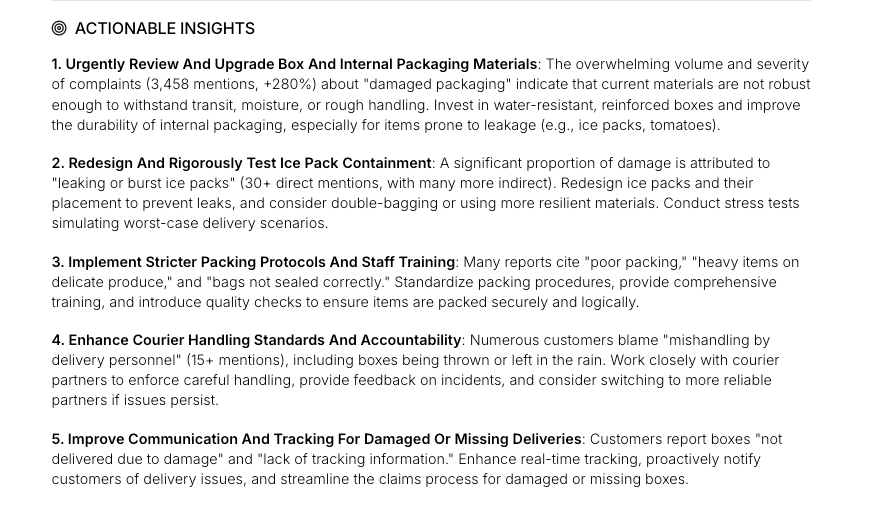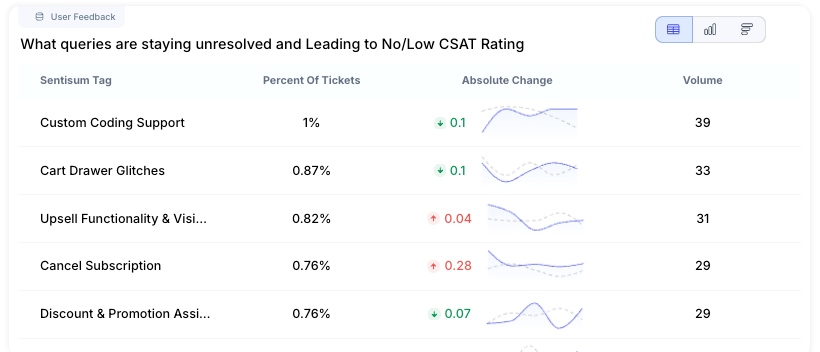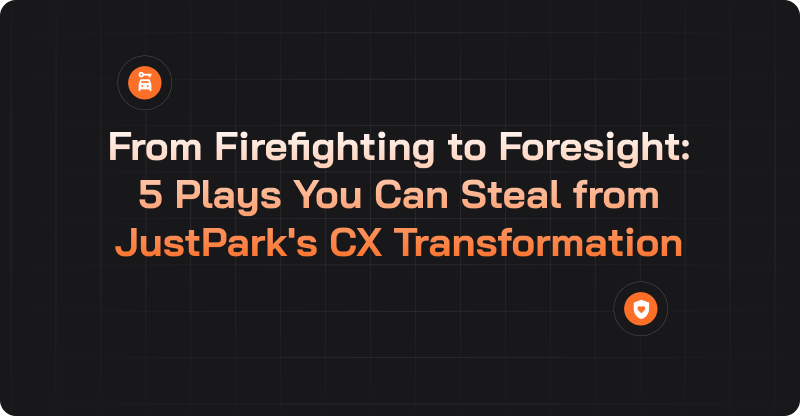When you're responsible for 14 million driver journeys, every broken customer experience eats into revenue, strains partnerships, and sends users to competitors.
Steven Burt is the Senior Director of Global Customer Experience at JustPark, a leading London-based technology platform that matches drivers with parking spaces. For him, the key challenge did not originate with a lack of feedback.
In fact, with Trustpilot reviews, app reviews, support tickets, NPS surveys, and social media mentions spread across five or six different systems, the brand had more than enough customer signals pouring in.
The real issue was speed. By the time the team manually pieced together patterns from disconnected sources, hundreds (sometimes thousands) of customer journeys had already been affected.
"It always felt like we were just sort of reacting and chasing our tail," Steve explains. He continues:
But Steve refused to accept this as normal.
He transformed JustPark's approach from constant firefighting to actively predicting and preventing CX issues before they spread.
In this guide, we’ve gathered five specific plays Steve used to move from reactive crisis management to proactive churn prevention. In essence, these are tactical moves you can steal and implement this week.
To help you pinpoint similar issues faster, we’ve also included a Proactive CX Playbook — on the house.
📽️Watch the 30-minute webinar
Get Steve’s exclusive insights, implementation details, and lessons learned from JustPark's CX transformation: Stop Reacting to CX Fires: How JustPark Built a Proactive Early‑Warning System (Killed AHT Worship)
Making Reactive Predictive: 5 Plays That Revamped JustPark's Approach to CX
Here are the five plays that Steve considers to be particularly constructive for any CX leader dealing with a similar situation:
1. Stay Connected to the Raw Customer Voice
To begin with, Steve made it a point to read customer tickets every week.
Not because he doesn't trust his team, but because he learned something from Jeff Bezos that changed his approach to CX leadership.
"I remember reading a thing on how Jeff Bezos and the C-suite at Amazon would go down to the customer support centre once a week and take calls from customers," he explains. They did this to bypass the ‘filter’ effect:
- Every layer between leadership and customers dilutes feedback.
- Agents categorise based on their understanding.
- Managers summarise based on what they think matters.
So, by the time the customer pain point reaches executives, it's already sanitised and stripped of emotional context.
That is why he still follows this practice. "Even a couple of days ago”, he admits, “I dove into the odd support ticket just to really keep my finger on the pulse."
Why This Hands-On Approach Changes Everything
This practice completely changes how Steve shows up in executive meetings.
For instance, when leadership asks what customers think about a feature or pain point, Steve doesn't just reference analysed data. He shares what he has heard directly from customers.
"I'm also getting straight from the mouth of the customer. I'm getting that absolute cold, hard feedback."
In the process, his instincts sharpen. He spots patterns earlier and understands what genuinely frustrates drivers versus what they simply tolerate.
What CX Leaders Can Start With
- Deep Dive Reading: Block 45 minutes this Friday to read 25 support tickets — not summaries, raw tickets.
- Analysis & Action: Log three recurring themes and identify one quick fix your team could ship.
- Rhythm Setting: Schedule this weekly if possible, or monthly at a minimum.
- Launch Amplification: During product launches, increase to twice a week.
- Team Education: Share what you learn in your next team meeting using specific customer examples.
Executive Advocacy: Bring those verbatim quotes to executive meetings when discussing priorities.
2. Catch Problems Before They Become Crises
Before implementing real-time detection, problems at JustPark often seemed to appear out of nowhere.
For instance, complaint volumes would suddenly spike, prompting the contact centre to alert the team. But by then, hundreds of driver journeys had already been affected.
"We'd be hearing problems after they'd already hurt someone's experience," Steve notes. "Drivers were the ones telling us when something was broken, but only when it hit enough volume for it to be noticeable."
This meant learning about issues only after burning enough customer journeys to trigger statistically significant complaint volumes. The bottom line: the damage to trust, revenue, and brand was already done.
Catching the Thousand-Dollar Problem
The turning point came with AI-native anomaly detection that flags unusual patterns as they emerge. One example perfectly illustrates the value.
"We were able to very quickly spot that there were some issues with a very big partner of ours," Steve shares. "Multiple dozens of drivers per day using multiple car parks were all having problems with barriers."
Barrier problems weren't uncommon, which made them tricky. It’s the volume that created noise. Without AI-powered pattern recognition, it would have been easy to dismiss these as normal friction.
"We get a lot of problems with barriers anyway. So it's hard to sometimes sort of remove the noise from that feedback. But actually, with SentiSum in place, we were able to kind of dig into exactly what customers were talking about and saying."
So, what was the root cause?
A missing piece of technology that prevented drivers from updating their license plate details. That small feature gap was costing thousands in revenue as drivers abandoned bookings or needed manual support intervention.
“It saved us thousands in revenue,” Steve confirms.
This single insight, caught within weeks of implementing real-time anomaly detection, paid for the platform investment many times over.
👉 Want the complete story of how JustPark unified siloed feedback and built their early warning system?
Read the full case study: From Siloed Feedback to Instant Action: How JustPark Fixed Problems Before They Cost Thousands
Start With Basic Alerts
- Initial Setup: Set up volume-based alerts in your help desk for your top five issue categories.
- Threshold Configuration: Configure them to trigger at 150% of normal volume.
- Delivery Channel: Send alerts to a dedicated Slack channel.
- Ownership Assignment: Assign a clear owner for each alert category.
- Performance Tracking: Track how often alerts fire and whether they represent real issues.
- Refinement: Refine thresholds based on false positive rates.
- Next Level: Once you have that baseline working, evaluate AI-native platforms that explain why volume is spiking, not just that it is.
3. Deploy AI to Solve Real-World Problems, Not Vanity Projects
Another important aspect is that Steve refuses to implement AI for show. As he points out:
The 20-Click Chatbot Problem
When Steve joined JustPark, the company had over-digitized customer service. A chatbot was the primary support route, requiring over 20 clicks to reach a phone number.
What could be the issue here?
JustPark's customers are often in vehicles when they need help. In this scenario, making them navigate a chatbot while sitting at a broken parking barrier fundamentally misunderstood where customers were and what they needed.
Steve changed this within weeks. His formula is straight-cut: "If your customer is likely to be in a vehicle, don't give them a 20-click chatbot."
AI That Actually Helps
JustPark now uses AI in two ways, both focused on practical outcomes:
1. Voice of Customer (VoC) Analysis
- Continuous Analysis: AI-native Voice of Customer analysis runs continuously across all feedback channels.
- Commercial Use: The commercial team became one of the most active users, leveraging insights in quarterly business reviews with partners.
- Competitive Edge: They show exactly what drivers say about specific locations, turning feedback into a competitive differentiator.
2. AI-driven Self-Service
- Initial Offering: AI-powered self-service offers solutions when drivers submit tickets.
- Escalation Path: If the solution works, great. If not, drivers reach a human quickly.
"We've no problem with connecting drivers to humans,” Steve says, “but we always like to offer them 'does this solve your problem first,' and a large percentage of the time that's the case."
Here, the key difference from the previous over-digitized approach is intentionality. AI serves the customer journey, not the other way around.
Audit One AI Workflow This Week
CX leaders can start by reviewing one AI implementation.
Ask: How much customer effort does it actually reduce?
- If customers constantly bypass it, or if it needs more human intervention to fix errors than to do the task manually — retire it.
- If the concept is sound but execution falls short — improve it.
- If it measurably reduces effort — keep it.
Finally, ask yourself: Would we be proud to show this AI interaction to customers in a usability study?
If not, you already know the answer.
4. Replace Speed Metrics with Resolution Outcomes
Average Handle Time (AHT) is Steve's least favourite customer service metric.
When contact centre teams are incentivised to keep calls short, they're incentivised to close tickets quickly rather than solve problems completely. Customers get rushed. Complex issues get oversimplified. Root causes never surface.
The metric creates perverse outcomes. An agent who spends 15 minutes fully resolving a driver's problem (preventing future contacts) looks worse on the dashboard than an agent who provides a 5-minute temporary workaround that leads to three more contacts.
Measure Outcomes, Not Just Speed
JustPark replaced speed-focused metrics with outcome-focused alternatives.
Instead of Average Handle Time, the team measures First Contact Resolution and Customer Effort. "As long as we can prove that we're solving customer problems," Steve notes, that's what matters.
This shift aligns team incentives with customer outcomes:
- Agents are rewarded for thoroughly solving problems, not for rushing customers off the phone.
- The support team focuses on preventing repeat contacts by addressing root causes.
Moreover, when you measure resolution and effort rather than speed, you start asking different questions.
- Why are customers contacting us about this issue?
- Could we fix the underlying problem so they don’t need to contact us at all?
These questions lead to product fixes and operational changes that reduce total contact volume.
Complement AHT with Other Metrics
- Dashboard Metrics: Add First Contact Resolution (FCR) and Customer Effort Score (CES) to your dashboard.
- Prominence Shift: Make them more prominent than AHT.
- Team Communication: Explain to your team why the metrics are changing.
- Best Practice Example: Share examples of thorough resolutions that prevented future contacts.
- Review Adjustment: Weight FCR and CES more heavily in performance reviews.
- Target Modification: Reduce or remove AHT targets.
- Incentive & Recognition: Celebrate agents who resolve complex problems completely, even if the calls take longer.

5. Turn Customer Feedback Into Cross-Functional Fuel
In most organisations, the Voice of Customer is owned by CX teams. They analyse feedback, create reports, and present findings. Other departments nod politely, then go back to their own priorities.
Steve deliberately broke this pattern:
The Internal Road Show
This cross-functional adoption didn’t happen by accident. Steve ran a "SentiSum road show" pilot within JustPark using two key tactics.
- Video for Executives: At his CEO’s suggestion, Steve created a short video pitching the platform to the executive team. This gave him airtime he might not otherwise have had.
Executives could watch it at their convenience and share feedback asynchronously. "The C-suite team really understood what it meant, what the product was, and what it could do."
- Departmental Sessions: Steve scheduled hour-long sessions with individual departments, customising the message for each:
- To Product: here's what's causing friction
- To Marketing: here's the language customers actually use
- To Commercial: here's feedback about specific partner locations
"If I had to do this again, that's the one thing I would do differently," Steve admits. "I'd probably do that internal road show within the first few weeks. I think that would have made a big difference."
How Commercial Teams Use VoC
JustPark's commercial team now uses feedback in multiple ways.
They draw on insights during quarterly business reviews with partners, showing specific feedback about locations. They also identify operational issues, such as broken barriers, before they escalate.
In addition, they use VoC in client pitches to demonstrate JustPark’s commitment to continuous improvement.
The impact shows up in decision-making speed:
- Process Efficiency: The impact shows up in decision-making speed. Instead of having five, six, or seven meetings trying to decide what the priorities are, you can really condense those down to two to three meetings.
- Outcome Certainty: What you're coming out of that process is not a gamble of what might work. It's a focus on pain points that you are actually fixing, leading to more effective outcomes.
Give One Team Access This Month
- Initial Access & Review: Give your sales or operations team access to your VoC dashboard this month. Schedule a 20-minute weekly review. Keep it simple: top three themes from customer feedback, one deep dive with verbatims, action items this team can own, and wins from the previous week.
- Ease of Access: Make access easy. Push insights to where teams already work (Slack, Teams, or email). Create role-based views so each team sees what matters to them. Celebrate when their actions improve customer feedback.
Altogether, these five plays transform how your organisation approaches customer experience. You become more proactive and constantly alert in your approach: from isolated CX insights to company-wide customer intelligence, from chasing vanity metrics to achieving outcomes that matter.
How SentiSum Empowers These Plays Into Reality
Steve’s transformation at JustPark wasn’t only about changing how teams thought or ran internal pilots. It needed the right technology foundation, a platform that could truly make proactive customer experience possible.
Here’s what becomes possible when you use an AI-native Voice of Customer platform built for retention-driven businesses:
You Stop Drowning in Feedback and Start Acting on Patterns
As we noted, JustPark had feedback scattered across Trustpilot, app reviews, support tickets, NPS surveys, and social media. Each told a small part of the story, but none gave the full picture.
SentiSum unified all those signals into one single intelligence hub.
Kyo, the AI agent, continuously analyses feedback across every channel, surfaces what's actually breaking, and suggests next-best items.
And it’s not based on what teams think might be going wrong. It’s exactly what customers are explicitly telling you is broken, in their own words, with the evidence to back it up.

That’s how Steve uncovered the barrier issue that was frustrating dozens of drivers every day. Like we said, the AI detected an unusual pattern in barrier-related complaints, cut through the noise, and revealed the root cause: a missing license plate change feature.
Fixing that single issue helped JustPark recover thousands in potential lost revenue.
You Predict Issues Before Customers Feel the Pain
Most traditional VoC tools only tell you what’s already gone wrong. By the time a pattern shows up on your dashboard, the damage has already happened: revenue lost, trust eroded, and negative reviews out in the open.
SentiSum's real-time anomaly detection flips this dynamic. The platform continuously monitors feedback patterns and automatically flags when something unusual emerges. Not just volume spikes (those are obvious), but subtle shifts in sentiment, emerging complaint patterns, or friction appearing in areas that were previously seamless.

So, when a product glitch appears, a partner integration falters, or a checkout flow starts to frustrate customers, you’re alerted straight away.
In fact, the commercial team at JustPark now uses these insights in partner quarterly business reviews, precisely what drivers experience at specific locations, long before small issues grow into relationship-damaging problems.
You Make Every Team a Customer Champion
The real breakthrough wasn't just that JustPark's CX team gained better insights. It was that those insights became accessible to everyone who needed them,
- Product teams stopped debating what to build next. They could see exactly which features were breaking journeys and where friction was costing conversions.
- Marketing teams began using the same language customers use, rather than relying on assumptions.
- Operations teams were able to spot and resolve service failures early.
SentiSum delivers insights in plain, accessible language, not data science jargon. Teams ask questions in natural language and get clear, evidenced-backed answers.

Kyo, the AI agent, also shares relevant intelligence directly to Slack and Teams channels, meeting people where they already work. No new or extra logins. No dashboard hunting. Just the right information at the right moment.
As a result, VoC evolves from a CX-owned initiative into company-wide strategic intelligence that drives aligned, cross-functional action.
You Prove CX Impact in Clear Revenue Terms
Steve didn’t win over JustPark’s leadership with polished dashboards. He showed them real outcomes:
- How faster detection protects revenue
- How fixing root causes reduces support volume
- How preventing churn compounds over time
SentiSum makes this connection explicit.
The platform tracks which issues trigger repeat contacts, what's driving churn risk, and where operational failures are costing revenue. When you fix a root cause, the impact shows up clearly: fewer contacts, higher resolution rates, better sentiment, and protected revenue.

That’s why JustPark’s COO backed the project immediately. The platform sits right at the intersection of customer experience and data, two areas he deeply values. The ROI wasn't theoretical. It was measurable within weeks.
Therefore, you make CX investment decisions with the same rigor as product or sales investments, backed by clear ROI.
Start Your CX Transformation This Week
These five plays are the same moves that helped JustPark shift from constantly reacting to crises to predicting and preventing them. Here is a recap:
The best part? You don't need to implement all five at once. Start with one that feels most urgent for your organisation right now.
- If leadership keeps asking "what do customers think?": Start with Play 1. Block 45 minutes on Friday to read 25 raw support tickets. Log three recurring themes and one quick fix. You’ll walk into executive meetings far more confident.
- If your biggest pain is surprise crises: Begin with Play 2. Set up volume-based alerts for your top five issue categories. Trigger at 150% of normal volume. You'll start catching problems hours earlier than you do today.
- If you're drowning in AI vendor pitches: Start with Play 3. Audit one AI workflow. Keep it, kill it, or upgrade it based on how much customer effort it actually reduces. Stop paying for vanity and invest in value.
- If your team is stuck in speed-metric hell: Start with Play 4. Add First Contact Resolution to your dashboard this week and make it more prominent than Average Handle Time. Give your team permission to solve problems fully.
- If CX feels disconnected from the rest of the business: Start with Play 5. Give one non-CX team access to VoC insights. Schedule a 20-minute weekly review and watch what happens when product or commercial teams see customer truth first-hand.
Pick one play. Implement it this week. Then share this framework with your operations and commercial leads so Voice of Customer becomes a shared scoreboard across your organisation.
The difference between firefighting and foresight isn't resources or team size. It's whether you’re focused on what happened yesterday or what’s emerging right now.
To remember one of Steve's key learning from the episode:
See How SentiSum Helps You Put These Plays Into Action
We’ve explored in detail how JustPark geared up from reactive approaches to proactive churn prevention using SentiSum's AI-native Voice of Customer platform.
Purpose-built for subscription and transaction-based businesses, SentiSum unifies feedback from support tickets, reviews, surveys, chat, calls, and social media into a single real-time intelligence hub.
Kyo, SentiSum’s AI agent, highlights anomalies, detects churn risks, and recommends next-best actions before issues spread.
Book a demo to see how SentiSum can help your team move from firefighting to foresight today.
Heading 1
Heading 2
Heading 3
Heading 4
Heading 5
Heading 6
Lorem ipsum dolor sit amet, consectetur adipiscing elit, sed do eiusmod tempor incididunt ut labore et dolore magna aliqua. Ut enim ad minim veniam, quis nostrud exercitation ullamco laboris nisi ut aliquip ex ea commodo consequat. Duis aute irure dolor in reprehenderit in voluptate velit esse cillum dolore eu fugiat nulla pariatur.
Block quote
Ordered list
- Item 1
- Item 2
- Item 3
Unordered list
- Item A
- Item B
- Item C
Bold text
Emphasis
Superscript
Subscript

.webp)






.png)
.png)
.webp)
.svg)
.svg)







